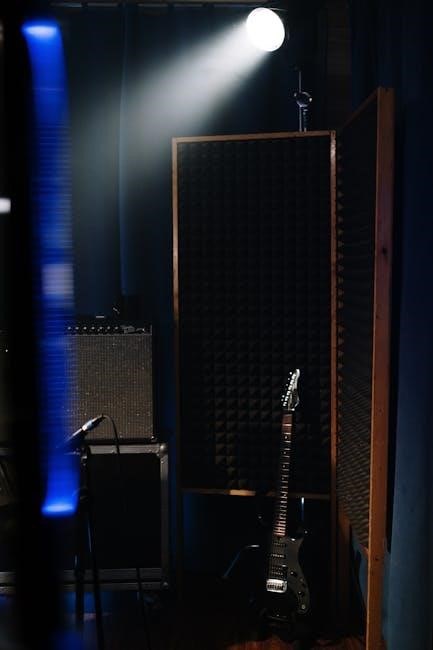The CAGED system is a powerful tool for understanding the guitar fretboard by linking scales to common chord shapes like C, A, G, E, and D. It helps guitarists visualize and connect chords, scales, and arpeggios, making improvisation and songwriting more accessible while unlocking the guitar’s logical layout. This method is especially useful for mapping major chords and barre chords across the fretboard, providing a foundational framework for mastering the guitar.
What is the CAGED System?
The CAGED system is a guitar playing method that maps chords, scales, and arpeggios across the fretboard using five basic open chord shapes: C, A, G, E, and D. These shapes serve as foundational patterns that guitarists can move up and down the neck to play chords and scales in various keys. By visualizing these shapes, players can better understand the guitar’s layout and improve their ability to play chords, scales, and arpeggios in different positions. This system simplifies learning and enhances musical expression by providing a logical framework for navigating the fretboard.
Importance of Understanding the Guitar Fretboard
Importance of Understanding the Guitar Fretboard
Understanding the guitar fretboard is crucial for mastering the CAGED system. It simplifies navigation, allowing guitarists to identify patterns and shapes quickly. This knowledge enhances improvisation and songwriting by providing a clear framework. Guitarists can move chords and scales smoothly across the neck, unlocking the guitar’s full potential. Fretboard understanding boosts confidence and creativity, enabling exploration of various musical styles. It’s the foundation for applying the CAGED system effectively and achieving musical fluency.
Overview of the CAGED System’s Benefits

The CAGED system offers numerous benefits for guitarists, simplifying complex fretboard concepts into a logical framework. It enhances improvisation and songwriting by providing a clear visual guide for chords, scales, and arpeggios. This system bridges the gap between open and barre chords, allowing seamless transitions across the neck. By mastering the five basic shapes, guitarists can access any key and position, unlocking endless musical possibilities. The CAGED system also fosters a deeper understanding of harmony and theory, making it an indispensable tool for musicians seeking to elevate their skills and creativity.

Key Concepts of the CAGED System
The CAGED system revolves around five foundational chord shapes—C, A, G, E, and D—used to map the guitar fretboard, aiding in mastering chords, scales, and arpeggios seamlessly.
Origin and Development of the CAGED System
The CAGED system is named after the five basic open chords—C, A, G, E, and D—which form the foundation of its framework. Developed to simplify the guitar fretboard, it emerged as a method to map chords, scales, and arpeggios systematically. The system emphasizes understanding the relationship between these chord shapes and their variations across the neck. Over time, it evolved into a comprehensive tool for learning and mastering the guitar, offering a logical approach to improvisation, composition, and navigation. Its origins lie in the need to connect theoretical concepts with practical playing, making it a cornerstone of modern guitar education.
How the CAGED System Works
The CAGED system operates by using five foundational open chords—C, A, G, E, and D—as templates to map the guitar fretboard. These shapes are moved up and down the neck to create barre chords, scales, and arpeggios in different keys. By identifying these shapes, players can locate notes, intervals, and chord tones efficiently. The system connects chords, scales, and arpeggios, providing a visual and logical framework for understanding the fretboard. This method simplifies finding chord voicings, scale patterns, and arpeggios in any key, making it an invaluable tool for improvisation, composition, and mastering the guitar’s layout.
The Five Basic Chord Shapes: C, A, G, E, and D
The CAGED system revolves around five open chord shapes: C, A, G, E, and D. These foundational chords are learned in their open forms and then transposed up the fretboard as barre chords. Each shape corresponds to a specific key and serves as a visual template for identifying notes, intervals, and chord tones. By memorizing these shapes, guitarists can navigate the fretboard more effectively, connecting chords, scales, and arpeggios seamlessly. These five shapes form the cornerstone of the CAGED system, enabling players to explore various musical applications with clarity and precision.

Chords in the CAGED System
The CAGED system uses five basic chord shapes (C, A, G, E, D) to map chords across the fretboard, simplifying the transition between open and barre chords.
Open Chords vs. Barre Chords
Open chords and barre chords are fundamental components of the CAGED system. Open chords utilize open strings and are typically played in the first few frets, offering a bright, clear sound. In contrast, barre chords involve fretting all strings with one finger, allowing for chords to be transposed up the neck. The CAGED system connects these open chord shapes to their barre chord equivalents, enabling guitarists to play any major or minor chord in multiple positions. This relationship is crucial for mapping chords across the fretboard and enhancing musical versatility. Mastering this connection unlocks various musical possibilities, making it easier to improvise and compose. By understanding how open chords transform into barre chords, players can navigate the fretboard more effectively and explore a wide range of harmonic possibilities. This foundational concept is essential for advancing guitar skills and deepening one’s musical expression.

Mapping Major Chords Across the Fretboard
The CAGED system provides a straightforward method for mapping major chords across the fretboard by using the five basic chord shapes: C, A, G, E, and D. These shapes can be transposed up the neck to play chords in any key, as they correspond to the intervals of the major scale. By visualizing these shapes, guitarists can easily identify chord tones and build chords in multiple positions. This approach simplifies navigation and enhances musical expression. The system also highlights how these shapes relate to open chords, allowing for a seamless transition between open and barre chord voicings. This consistency makes it easier to improvise and compose music effectively;
Understanding Chord Shapes and Their Variations
The CAGED system revolves around five foundational chord shapes—C, A, G, E, and D—that form the basis of most chords. These shapes can be transposed up the neck to create chords in various keys. By understanding these shapes, guitarists can identify chord tones and build variations like minor, seventh, and extended chords. The system emphasizes visualizing these shapes across the fretboard, allowing for seamless transitions between chords and scales. This approach not only simplifies chord construction but also enhances musical expression by connecting chords to their underlying scales and arpeggios, making it a versatile tool for both rhythm and lead playing.

Scales and Arpeggios in the CAGED System
The CAGED system seamlessly integrates scales and arpeggios, allowing guitarists to map major scales across the fretboard using the five chord shapes. This method enhances soloing and musicality.
Applying the CAGED System to Guitar Scales

Applying the CAGED system to guitar scales involves using the five chord shapes as visual references to navigate scales across the fretboard. By aligning scales with these shapes, guitarists can identify patterns and intervals, making it easier to play in any key. This method also helps in connecting scales to chords, enabling seamless transitions during solos and improvisations. The system simplifies learning complex scales by breaking them into familiar, manageable forms, enhancing overall fretboard understanding and musical versatility. This approach is particularly effective for mastering major and minor scales efficiently.
Major and Minor Triads Within the CAGED System

The CAGED system integrates major and minor triads by aligning them with the five chord shapes. Each shape corresponds to a root position triad, providing a clear visual framework for understanding chord construction. Major triads are built from the root, third, and fifth, while minor triads use the root, minor third, and fifth. These triads form the foundation of chords and scales, allowing guitarists to connect harmonic structures across the fretboard. By mastering these triads within the CAGED system, players can enhance their improvisation and composition skills, ensuring a deeper understanding of music theory applied to the guitar.
Arpeggios and Their Role in the System
Arpeggios are a fundamental component of the CAGED system, offering a smooth transition between chords and scales. They are built from the same chord shapes, allowing guitarists to connect harmonic structures seamlessly. By breaking down chords into their individual notes, arpeggios provide a fluid way to navigate the fretboard. This technique enhances improvisation and melody writing, as it visually links chords to their corresponding scales. Arpeggios also emphasize the relationship between triads and extended chords, making them invaluable for understanding harmony and applying it in various musical contexts. Mastery of arpeggios within the CAGED system deepens a guitarist’s ability to create expressive and coherent solos.

Practical Applications of the CAGED System
The CAGED system is a versatile tool for guitarists, aiding in improvisation, solo construction, and songwriting. It enhances fretboard navigation and connects chords with scales, enabling creative expression and technical mastery efficiently. By applying CAGED shapes, musicians can explore various musical styles with confidence and precision, making it an essential method for both beginners and advanced players seeking to expand their skills. This system simplifies complex concepts, providing a clear pathway to musical fluency and artistry. Regular practice with CAGED shapes ensures consistent progress and a deeper understanding of the guitar’s layout. It’s a must-learn for serious guitarists aiming to elevate their playing to new heights. The practical benefits of the CAGED system make it an indispensable resource for any guitarist looking to enhance their craft and unlock the full potential of their instrument. With the CAGED system, mastering the fretboard becomes an achievable and rewarding journey. Guitarists can apply these principles to create rich, dynamic music that resonates with audiences. Embracing the CAGED system transforms playing into a more intuitive and expressive experience, fostering growth and inspiration for years to come. By integrating CAGED into daily practice, guitarists can overcome challenges and develop a sophisticated, nuanced style. The system’s applications are limitless, offering endless opportunities for exploration and innovation. As a result, the CAGED system stands as a cornerstone of modern guitar education, empowering players to reach their full potential. Through dedicated study and application, the CAGED system becomes a powerful ally in the pursuit of musical excellence. Guitarists who embrace this method often find their creativity and technical abilities flourishing in ways they never thought possible. The CAGED system is not just a learning tool; it’s a gateway to musical freedom and expression. By harnessing its power, guitarists can unlock new dimensions of sound and artistry, ensuring a lifelong journey of discovery and enjoyment on the instrument. The practical applications of the CAGED system are vast and transformative, making it an essential part of every guitarist’s toolkit. Whether improvising, composing, or simply improving technique, the CAGED system provides the insights and strategies needed to succeed. It’s a testament to the guitar’s rich harmonic possibilities and a key to unlocking them. For any guitarist seeking to enhance their skills and expand their musical horizons, the CAGED system is an invaluable resource that delivers results. With consistent practice and a deep understanding of its principles, the CAGED system can elevate one’s playing to extraordinary levels. It’s a method that not only teaches the mechanics of the guitar but also nurtures the musicality within every player. The practical applications of the CAGED system are a clear path to mastery, guiding guitarists through the complexities of music theory and fretboard navigation with clarity and precision. Embracing this system opens doors to new sounds, styles, and possibilities, enriching the guitarist’s journey and ensuring a lifetime of musical fulfillment. The CAGED system is more than a teaching method; it’s a powerful framework that connects theory to practice, enabling guitarists to express themselves with confidence and artistry. By mastering the CAGED system, guitarists gain the tools to navigate the fretboard effortlessly, create compelling solos, and craft meaningful music that leaves a lasting impression. It’s a system that grows with the player, offering depth and complexity as their skills evolve. The practical applications of the CAGED system are a testament to its enduring value in modern guitar education. Guitarists who dedicate themselves to this method often experience a profound transformation in their playing, unlocking new levels of creativity and technical prowess. The CAGED system is a journey, not a destination, and its practical applications ensure that the learning process is engaging, rewarding, and infinitely beneficial. As guitarists delve deeper into the CAGED system, they discover a world of possibilities that enhance their musicality and inspire their passion for the instrument. The system’s emphasis on connection and integration makes it a holistic approach to guitar playing, fostering a deeper understanding of music and the guitar’s role within it. The practical applications of the CAGED system are a cornerstone of effective guitar education, providing players with the knowledge and skills needed to excel in various musical settings. By applying the principles of the CAGED system, guitarists can overcome challenges, explore new styles, and develop a unique voice that sets them apart. This method is a celebration of the guitar’s versatility and a guide to harnessing its full potential. The practical applications of the CAGED system are a powerful reminder of the transformative power of music education, offering guitarists a clear path to achieving their artistic goals. Through the CAGED system, the guitar becomes an extension of the player’s creativity, a tool for self-expression and connection with others. The system’s practical applications ensure that every practice session is productive, every performance is compelling, and every musical endeavor is fulfilling. The CAGED system is a trusted companion on the guitarist’s journey, providing inspiration, guidance, and the technical foundation needed to succeed. Its practical applications are a testament to its effectiveness and the impact it has on a guitarist’s growth and development. By embracing the CAGED system, guitarists can realize their full potential and contribute meaningfully to the world of music. The practical applications of this system are a gateway to a lifetime of musical exploration and enjoyment, making it an essential part of every guitarist’s education. The CAGED system’s ability to connect theory with practice creates a seamless learning experience, allowing guitarists to apply their knowledge in real-world musical situations. This approach not only enhances technical skills but also nurtures musicality, resulting in well-rounded players who are capable of expressing themselves with precision and emotion. The practical applications of the CAGED system ensure that guitarists are equipped with the tools necessary to adapt to any musical context, whether they’re playing in a band, accompanying a vocalist, or performing solo. It’s a method that fosters versatility and resilience, enabling guitarists to thrive in diverse musical environments. The CAGED system’s emphasis on practical application makes it a favorite among both educators and students, as it delivers measurable progress and a sense of accomplishment. Guitarists who commit to learning this system often remark on its ability to demystify complex concepts and make them accessible, even for those with limited prior knowledge. The practical applications of the CAGED system are a shining example of how music education can be both effective and engaging, providing a structured yet flexible approach to learning the guitar. By focusing on real-world applications, the CAGED system prepares guitarists for the challenges and opportunities they’ll encounter in their musical journeys. This method is a celebration of the guitar’s expressive potential and a testament to the power of systematic learning. The practical applications of the CAGED system ensure that every guitarist, regardless of their background or experience level, can benefit from its insights and strategies. It’s a system that bridges the gap between theory and practice, offering a comprehensive understanding of the guitar that is both intellectually stimulating and musically rewarding. The CAGED system’s practical applications are a source of inspiration and motivation for guitarists, helping them stay focused and committed to their craft. By applying the principles of this system, players can achieve their goals and continue to grow as musicians, always finding new ways to express themselves through the guitar. The practical applications of the CAGED system are a powerful tool for unlocking the guitar’s secrets and realizing one’s full musical potential. They provide a clear, structured approach to learning that yields lasting results and a deeper appreciation for the instrument. Guitarists who immerse themselves in the CAGED system often develop a lifelong passion for music and a profound respect for the guitar’s rich harmonic possibilities. The practical applications of this system are a testament to its enduring relevance and the transformative impact it has on a guitarist’s skills and artistry; By mastering the CAGED system, guitarists gain the confidence and expertise needed to excel in any musical setting, from intimate performances to large-scale productions. This method is a cornerstone of modern guitar education, offering a balanced blend of theory and practice that prepares players for the demands of contemporary music. The practical applications of the CAGED system ensure that guitarists are well-equipped to handle the challenges of today’s diverse musical landscape, whether they’re playing in a band, composing original music, or exploring new styles. It’s a system that adapts to the needs of the player, providing a flexible framework for learning that can be tailored to individual goals and interests. The practical applications of the CAGED system are a celebration of the guitar’s versatility and a reflection of its enduring appeal in modern music. By embracing this method, guitarists can unlock new dimensions of sound and creativity, ensuring a rewarding and fulfilling musical journey. The CAGED system’s practical applications are a powerful reminder of the guitar’s potential to inspire and transform, offering players a pathway to mastery and artistry. Through dedicated practice and a deep understanding of its principles, the CAGED system becomes a trusted guide, leading guitarists to new heights of musical expression and technical proficiency. The practical applications of this system are a testament to its effectiveness and the impact it has on a guitarist’s growth and development. By utilizing the CAGED system, guitarists can realize their full potential and contribute meaningfully to the world of music. The practical applications of this system are a gateway to a lifetime of musical exploration and enjoyment, making it an essential part of every guitarist’s education. The CAGED system’s ability to connect theory with practice creates a seamless learning experience, allowing guitarists to apply their knowledge in real-world musical situations. This approach not only enhances technical skills but also nurtures musicality, resulting in well-rounded players who are capable of expressing themselves with precision and emotion. The practical applications of the CAGED system ensure that guitarists are equipped with the tools necessary to adapt to any musical context, whether they’re playing in a band, accompanying a vocalist, or performing solo. It’s a method that fosters versatility and resilience, enabling guitarists to thrive in diverse musical environments. The CAGED system’s emphasis on practical application makes it a favorite among both educators and students, as
Improvisation Techniques Using the CAGED System
The CAGED system provides a structured approach to improvisation by mapping chord shapes across the fretboard. Guitarists can seamlessly connect scales and arpeggios, creating fluid, cohesive solos. By visualizing CAGED shapes, players can identify key tones and transitions, enabling intuitive phrasing. This method enhances fretboard navigation, allowing for spontaneous, melodically rich improvisation. It bridges gaps between chords and scales, offering endless possibilities for musical expression and creativity. Regular practice with CAGED shapes builds confidence and mastery, making improvisation a natural extension of guitar playing. This system is a powerful tool for unlocking the guitar’s full improvisational potential.
Building Guitar Solos with CAGED Shapes
Using the CAGED system, guitarists can construct solos by connecting chord shapes and scales seamlessly. Each shape provides a framework for melodies, allowing smooth transitions across the fretboard. By targeting key tones within CAGED forms, players craft meaningful, structured solos. This approach enhances phrasing and harmonic accuracy, making solos sound purposeful and coherent. It also encourages creativity, enabling the exploration of various musical styles. Regular practice with CAGED shapes builds confidence and mastery, transforming solos into powerful expressions of artistry and emotion. This method is essential for any guitarist aiming to elevate their soloing abilities to new heights.
Using the CAGED System for Songwriting
The CAGED system is a valuable tool for songwriting, offering a structured approach to creating harmonically rich music. By understanding how chords and scales connect, songwriters can craft cohesive progressions and transitions. The system provides a clear framework for exploring chord voicings, arpeggios, and melodies, ensuring songs are both musically sound and creatively engaging. It also aids in identifying key centers and harmonic movements, helping writers to build tension and resolution effectively. With the CAGED system, songwriters can unlock new ideas and express their musical vision with clarity and precision, making it an indispensable resource for composing guitar-driven music.
Advanced Techniques and Concepts
The CAGED system enhances understanding of modes, harmonic substitutions, and altered dominants, allowing for advanced musical exploration and integration with other guitar systems and techniques seamlessly.
Understanding Modes and Their Connection to the CAGED System
The CAGED system seamlessly connects to musical modes, as each chord shape corresponds to specific scale patterns. For instance, the C shape aligns with the Ionian mode, while the A shape reflects the Lydian mode. This connection allows guitarists to navigate modal interchange effortlessly, enhancing improvisation and composition. By understanding how modes relate to CAGED shapes, players can access a wide harmonic palette, creating rich, nuanced solos and melodies. This integration empowers musicians to explore advanced techniques while maintaining a strong foundation in fretboard logic and musical theory.
Harmonic Substitutions and Altered Dominants
The CAGED system is a powerful framework for understanding harmonic substitutions and altered dominants. By recognizing chord shapes and their relationships, guitarists can substitute chords within a key to create tension and interest. Altered dominants, such as flat ninths and sharp ninths, can be visually mapped using CAGED shapes, allowing for intricate harmonic explorations. This approach enhances versatility in improvisation and composition, enabling players to craft richer, more complex sounds while maintaining harmonic clarity. The CAGED system’s visual nature makes it an ideal tool for mastering these advanced harmonic techniques and expanding musical expression.
Integration with Other Guitar Systems
The CAGED system seamlessly integrates with other guitar systems, enhancing overall fretboard understanding. While it focuses on chord shapes, it complements scale-based systems like the 3 Notes Per String method. This integration allows guitarists to combine chord and scale knowledge, creating a holistic approach to playing. By merging CAGED with other techniques, players can navigate the fretboard more fluidly, connecting chords, scales, and arpeggios effortlessly. This versatility makes the CAGED system a valuable tool for expanding musical expression and mastering advanced guitar techniques, ensuring a well-rounded skill set for any guitarist.
Common Challenges and Troubleshooting
Overcoming fretboard confusion and memorizing CAGED shapes can be daunting. Transitioning smoothly between chord forms requires patience. Regular practice and mnemonics can help master the system effectively.
Overcoming Fretboard Confusion
Fretboard confusion often arises from the guitar’s tuning, which creates a layout that isn’t linear. The CAGED system simplifies this by using familiar chord shapes as visual markers; By focusing on the relationships between these shapes, players can reduce confusion. Start with the open C chord and gradually map its barre chord equivalents up the neck. This approach helps build a mental map of the fretboard, making it easier to navigate. Regular practice and visualization exercises can further solidify this understanding, turning confusion into clarity over time.
Addressing Misconceptions About the CAGED System

One common misconception is that the CAGED system is overly complicated or only for advanced players. In reality, it’s designed to simplify the fretboard by linking familiar chords to scales and arpeggios. Another myth is that it limits creativity, but it actually provides a flexible framework for improvisation and composition. Some critics argue it’s inefficient, yet its strength lies in its ability to connect various musical elements. By understanding these truths, guitarists can approach the CAGED system with clarity, unlocking its full potential to enhance their playing and musical understanding.
Tips for Effective Practice
Mastering the CAGED system requires consistent and focused practice. Start by familiarizing yourself with the five chord shapes in open positions before moving them up the neck. Practice scales and arpeggios in tandem with chords to build a seamless connection. Use a metronome to improve timing and ensure smooth transitions between shapes. Break the fretboard into smaller sections and gradually expand your range. Incorporate real songs or riffs to apply the system practically. Record your progress to identify areas for improvement. Most importantly, stay patient and persistent, as mastery unfolds over time with dedicated effort.
The CAGED system is a transformative tool for guitarists, offering deep fretboard understanding. To further your journey, explore advanced techniques, modes, and harmonic substitutions. Seek resources like PDF guides and video lessons to enhance your skills and apply the system creatively in improvisation and songwriting.
Summarizing the Key Takeaways
The CAGED system is a powerful framework for mastering the guitar fretboard by linking scales and chords to five foundational shapes: C, A, G, E, and D. It simplifies navigating the fretboard, enabling guitarists to map major and minor chords, scales, and arpeggios efficiently. This system enhances improvisation, songwriting, and understanding of music theory. By practicing CAGED shapes, players can build solos, explore modes, and integrate advanced techniques like harmonic substitutions. Consistent practice and exploring resources like PDF guides can deepen mastery, making the CAGED system an invaluable tool for guitarists of all levels.
Encouragement for Further Exploration
Mastering the CAGED system is a transformative journey that unlocks endless possibilities for guitarists. As you progress, challenge yourself to apply these shapes in improvisation and songwriting, exploring modes and advanced techniques like harmonic substitutions. Dedicate time to practice, as consistency is key to fluency. Dive into resources like PDF guides and video lessons to deepen your understanding. Embrace experimentation and creativity—the CAGED system is a gateway to musical expression. With persistence, you’ll navigate the fretboard with confidence, crafting solos and compositions that reflect your unique voice. Keep exploring and enjoying the rewarding process of mastering the guitar.
Recommended Resources for Continued Learning
To deepen your understanding of the CAGED system, explore comprehensive PDF guides that include fretboard diagrams and exercises. Websites like Guitar Tricks and TrueFire offer detailed video lessons and interactive tools. Additionally, forums like Reddit’s r/guitar and specialized music communities provide valuable insights and feedback. Consider eBooks focused on chord shapes, scales, and arpeggios within the CAGED framework. For hands-on practice, utilize apps like Fender Play or Guitar Pro to visualize and apply the system. These resources will help you master the CAGED system and unlock advanced techniques for improvisation and composition.
